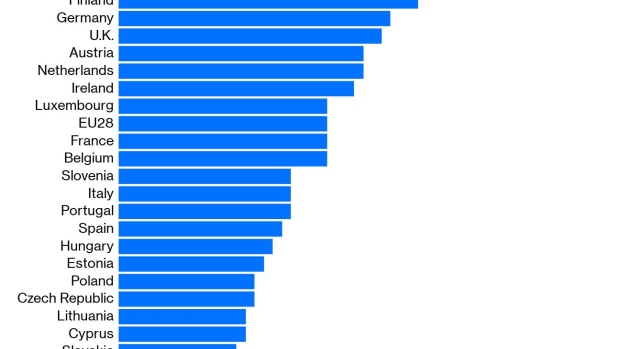Sep 19, 2019
Hey, EU, Don’t Make Climate Promises You Can’t Keep
, Bloomberg News

(Bloomberg Opinion) -- Ursula von der Leyen, the new European Commission president, wants to make Europe the first carbon-neutral continent by 2050. She’s promised to deliver a “European Green Deal” in the first 100 days of her tenure, which starts Nov. 1. The neutrality target, however, is unrealistic: It’s undermined by Europe’s economic divergence, which the European Union can hardly be expected to eliminate by 2050.
In June, when the matter of an EU commitment to carbon neutrality first came up, the adoption of the 2050 target was blocked by four countries: Poland, the Czech Republic, Hungary and Estonia. That’s not the list of opponents one might expect based on the long-term emissions history of EU members.
If one takes 1990 as the base year, all these countries except Estonia have decarbonized more than the EU as a whole, though not as much as the leader, Lithuania, where the population has shrunk by a quarter since 1990. But they did so because their inefficient Communist-era industries died. If one uses 2007 as the base year, the following decade’s trend looks startlingly different.
Between 2007 and 2017, all four carbon-neutrality dissidents reduced emissions more slowly than the EU as a whole. Poland was the worst laggard: Its emissions stood at 99% of the 2007 level in 2017. It was wealthy Denmark that led the EU in cutting emissions.
It’s no coincidence that the three EU countries that have set legally binding carbon neutrality targets (Sweden, the U.K. and France) as well as two of the three members that have included them in policy documents (Finland and Denmark) are wealthy countries. According to an EU-wide survey taken in April, the wealthier a nation, the more people in it consider climate change a matter of utmost importance.
Ever since the fall of Communism, Eastern European countries have emphasized economic growth over almost all other considerations, striving to catch up with the living standards of their western neighbors. Two Polish power plants are among the EU’s 10 highest-emission enterprises, but they and others like them helped make Poland one of the bloc’s fastest-growing economies.
All four of the dissident countries also have higher energy consumption levels per dwelling than the EU average. They inherited extremely inefficient housing from the Communist era, and they’ve had less money to spend than wealthier neighbors on lowering energy consumption rates.
Estonia, Hungary and the Czech Republic are the three countries with the oldest passenger car fleets in the EU. It’ll be especially hard to replace the old, smoke-belching vehicles on their roads with electric cars, even if battery-powered autos end up dominating in Scandinavia, Germany and France.
Fixing the disparities is, of course, mostly a matter of money. It’s been estimated that reaching the U.K.’s carbon-neutrality target will cost that country between 1% and 2% of economic output annually until 2050. The EU’s poorer nations probably would need to spend a higher proportion of their gross domestic product, and given the relatively low priority that voters in these countries assign to climate change, it’s hard to see how governments could justify the expense. On the other hand, if, under any new climate deal, the EU committed to creating a fund to subsidize the energy transition of the less wealthy members, the size of that fund would be severely limited by voter sentiment in the wealthier nations. Germans are already worried about the costs of their own decarbonization plan; it’ll be hard to get them to pay for Poland’s or Hungary’s.
Instead of trying to get eastern European countries to sign on to lofty EU climate goals, the bloc’s leadership should admit that eliminating economic disparity between its older and newer members is an important precondition for such ambitious common-goal setting. Ignoring this disparity is hypocritical. If some poorer countries sign on to the carbon neutrality goal in the expectation that the EU will fund their efforts and then fail to receive the expected funding, the goals simply will not be reached. And von der Leyen and her team won’t be around in 2050 to take responsibility.
Any “green deal” the EU can propose should set realistic emissions-reduction goals for specific countries based on their ability to pay. I doubt that kind of planning for the next 30 years can be completed in 100 days.
To contact the author of this story: Leonid Bershidsky at lbershidsky@bloomberg.net
To contact the editor responsible for this story: Jonathan Landman at jlandman4@bloomberg.net
This column does not necessarily reflect the opinion of the editorial board or Bloomberg LP and its owners.
Leonid Bershidsky is Bloomberg Opinion's Europe columnist. He was the founding editor of the Russian business daily Vedomosti and founded the opinion website Slon.ru.
©2019 Bloomberg L.P.


